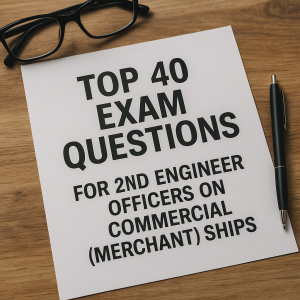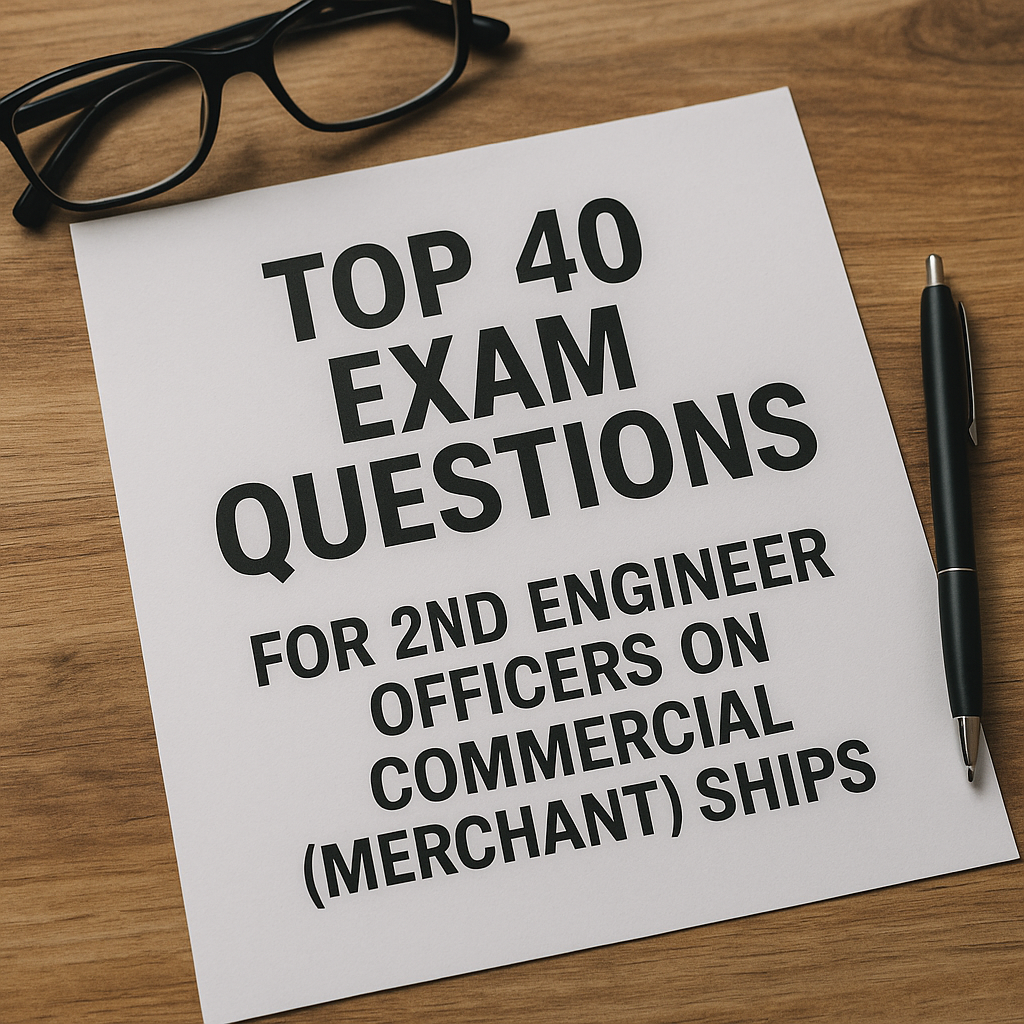 Prepare for your 2nd Engineer Officer exam with confidence. Explore the top 40 questions commonly asked during oral and written assessments for marine engineers on commercial ships—complete with real-world scenarios, STCW guidance, and expert tips.”
Prepare for your 2nd Engineer Officer exam with confidence. Explore the top 40 questions commonly asked during oral and written assessments for marine engineers on commercial ships—complete with real-world scenarios, STCW guidance, and expert tips.”
Achieving the rank of 2nd Engineer on a merchant ship is a pivotal step in a marine engineering career. Responsible for the day-to-day operation and management of the engine room, the 2nd Engineer must be well-versed in technical knowledge, leadership, safety procedures, and international maritime regulations. Whether you’re preparing for the UK MCA oral, AMSA assessments, Indian MEO Class II exam, or a Transport Canada certification, mastering the expected questions is key to success.
This guide presents 40 of the most frequently asked exam questions for 2nd Engineer Officers on commercial vessels. Each question is contextualised with real-life relevance, industry standards, and applicable regulations to help you answer like a professional—not just pass an exam.
Why 2nd Engineer Exams Matter in Modern Maritime Operations
As the officer in charge of engine room operations, the 2nd Engineer plays a critical role in ensuring the propulsion, auxiliary systems, and safety equipment are functioning reliably. According to the International Chamber of Shipping (ICS), over 90% of global trade is carried by sea, making the technical health of ships essential to the world economy. A single breakdown due to poor maintenance or human error can lead to delays, environmental damage, or even loss of life.
Exams test not only your theoretical knowledge but also your decision-making in high-pressure scenarios. With the industry moving toward digitalization, stricter IMO environmental regulations (e.g. MARPOL Annex VI, EEXI), and growing focus on cyber safety, a competent 2nd Engineer is more crucial than ever.
Core Exam Categories and Top Questions
Marine Diesel Engines and Auxiliary Systems
- Describe the start-up procedure for a MAN B&W two-stroke engine.
- Includes pre-lubrication, turning gear disengagement, air start sequence, jacket water and lube oil checks.
- What causes scavenge fire and how do you respond?
- Carbon deposits + oil mist; stop engine, engage fixed CO₂ system, ventilate after cooling.
- How is cylinder lubrication managed in a two-stroke engine?
- Through timed injection systems, controlled by load and sulphur content of fuel.
- What are signs of a cracked piston crown?
- Exhaust temp rise, scavenge drain oil leakage, knocking sound, visual inspection during overhaul.
- How do you control fuel injection timing in modern engines?
- Electronic control units (ME engines), cam-driven pumps (conventional).
Boilers and Steam Systems
- What are common boiler mountings and their functions?
- Safety valve (overpressure), water level gauge, pressure gauge, salinity test valve.
- Describe a boiler blowdown procedure.
- Isolate feed, open blowdown valve gradually, monitor level, close and reintroduce feed.
- What is foaming in a boiler and how is it prevented?
- Caused by oil contamination; use of antifoam agents, proper boiler water treatment.
- How does an economiser work?
- Recovers exhaust heat to preheat feedwater; increases thermal efficiency.
- Explain the purpose of the salinometer and conductivity cell.
- Measures salt content in steam condensate; prevents carry-over of seawater.
Refrigeration, Air Conditioning, and Fresh Water Generation
- Explain the basic cycle of a refrigeration system.
- Compression, condensation, expansion, evaporation.
- How do you handle a refrigerant leak?
- Isolate system, ventilate space, use gas detectors, report under F-Gas regulations.
- Describe how the freshwater generator operates.
- Uses vacuum evaporation (flash type), powered by jacket water heat.
- What is the effect of overcharging a refrigerant system?
- High condenser pressure, risk of liquid carryover to compressor.
- Why is brine density monitored in freshwater generation?
- Indicates performance; high density = poor separation or contamination.
Fuel Systems and Bunkering
- Explain fuel oil purification using centrifugal separators.
- Separates sludge, water, and oil via gravity difference in a rotating bowl.
- How do you manage a bunkering operation safely?
- Bunker checklist, comms with supplier, overflow monitoring, SOPEP readiness.
- What are the common signs of water contamination in fuel?
- Emulsification, reduced combustion efficiency, filter clogging.
- Describe the use of viscosity controllers in fuel oil systems.
- Maintain correct fuel viscosity for efficient combustion by adjusting heater.
- What documentation is required after bunkering?
- Bunker Delivery Note (BDN), fuel sample log, MARPOL Annex VI record.
Pumps and Steering Systems
- Differentiate between centrifugal and positive displacement pumps.
- Centrifugal for high flow/low pressure; PD for high pressure/low flow.
- How do you prime a centrifugal pump?
- Vent air from suction line, use vacuum pump or manual filling.
- What causes cavitation and how do you prevent it?
- Low pressure at impeller inlet; maintain NPSH, avoid throttling suction.
- Describe the electro-hydraulic steering gear system.
- Rudder controlled via servo valves and hydraulic rams powered by electric motors.
- What are your checks before entering a steering gear room?
- PPE, communication, permission from bridge, no oil leaks.
Safety Equipment and Emergency Procedures
- How do you respond to a crankcase explosion?
- Stop engine, isolate affected unit, check oil mist detector, inspect for damage.
- What is the function of the emergency bilge suction?
- Bypasses main bilge line in case of flooding; operated from engine room bottom.
- Explain how to test emergency generator weekly.
- Manual or automatic start test, load test, checking fuel and cooling systems.
- How do you test the fire detection system?
- Simulate heat/smoke at detectors, verify panel alerts, check reset function.
- What are the contents of the Engine Room Oil Record Book?
- Sludge transfer, bilge discharge, bunkering, tank cleaning (MARPOL Annex I compliance).
Pollution Prevention and Environmental Compliance
- What is the purpose of an oily water separator (OWS)?
- Removes oil from bilge water; <15 ppm discharge limit per MARPOL Annex I.
- What do you record in the Garbage Record Book?
- Type, amount, and disposal method of waste (Annex V).
- How is sludge managed onboard?
- Decanted, transferred to incinerator or shore, recorded in ORB.
- Explain the working principle of NOx reduction technologies.
- SCR systems inject urea into exhaust to convert NOx to nitrogen and water.
- What is EEXI and how does it affect engine operations?
- Energy Efficiency Existing Ship Index; may require power limitations or retrofits.
Automation, Monitoring, and Alarms
- How do you troubleshoot high jacket water temperature alarms?
- Check cooling water flow, pump status, thermostat, fouling in heat exchanger.
- Describe the role of the main engine remote control system.
- Allows bridge control of engine speed/start/stop; integrates with safety interlocks.
- What is the difference between hardwired and PLC-based alarms?
- Hardwired: fixed circuits; PLC: programmable and more flexible.
- How do you respond to a blackout situation?
- Start emergency generator, restore power to vital systems, identify cause.
- What are the key parameters monitored by the engine room monitoring system?
- Lube oil pressure, temperatures, tank levels, exhaust temps, alarms.
Case Studies and Real-World Scenarios
In 2021, a bulk carrier experienced main engine failure in the Malacca Strait due to incorrect lube oil viscosity settings. The 2nd Engineer had misconfigured the viscosity controller after a fuel changeover. According to the MAIB investigation, it highlighted the importance of continuous learning, attention to detail, and understanding automation systems.
Another case from 2022 involved an oil spill due to improper OWS bypassing. The engineer in charge claimed ignorance during questioning. This reinforces the need for STCW-compliant pollution prevention training and ethical accountability.
FAQ: Frequently Asked Questions
How much sea time is needed to sit for the 2nd Engineer exam?
Depends on the country. For instance, the UK MCA typically requires 12 months as 3rd Engineer (EOOW) plus completion of an approved training program.
Is simulator training mandatory for the oral exam?
Yes, for many flag states. Engine room simulators are used to assess real-time decision-making.
Should I memorise parameters or focus on understanding?
Both. Understand principles, but remember key values like lube oil pressure, T/C rpm, etc.
Can I use engine manuals during the orals?
No. But quoting the manufacturer’s standard practices shows competence.
How do I prepare for a competency-based oral?
Study real cases, conduct mock orals, review your own sea experience logs.
Conclusion
The 2nd Engineer’s oral or written exam is not just about checking boxes — it’s about proving that you’re ready to manage the heart of the ship with professionalism, technical skill, and safety-first thinking. These 40 questions are drawn from real-life scenarios, past assessments, and STCW Model Course guidance to help you think like a leader, not just an operator.
Prepare confidently, revise thoroughly, and enter the exam room with the mindset of a future Chief Engineer.
References
- STCW Convention & Code (https://www.imo.org/en/About/Conventions/Pages/STCW-Convention.aspx)
- MARPOL Annexes (https://www.imo.org/en/OurWork/Environment/Pages/Default.aspx)
- ISM Code (https://www.imo.org/en/OurWork/Safety/Pages/ISMCode.aspx)
- MAIB Reports (https://www.gov.uk/government/organisations/marine-accident-investigation-branch)
- Marine Insight (https://www.marineinsight.com)
- IMAREST (https://www.imarest.org)
- The Nautical Institute (https://www.nautinst.org)
- Lloyd’s Register (https://www.lr.org)
- Wärtsilä Technical Manuals (https://www.wartsila.com)
- Alfa Laval OWS and purifier systems (https://www.alfalaval.com)
- OCIMF Guidelines
- IMO Model Course 7.04 (Engineering Watch)
- ClassNK and DNV Machinery Class Notations
- Transport Canada Marine Safety & Security
- UK MCA Oral Exam Syllabus MGN 69
- Elsevier’s Marine Pollution Bulletin
- Ship Construction by D.J. Eyres
- Marine Diesel Engines by Nigel Calder


Thank youuuuu